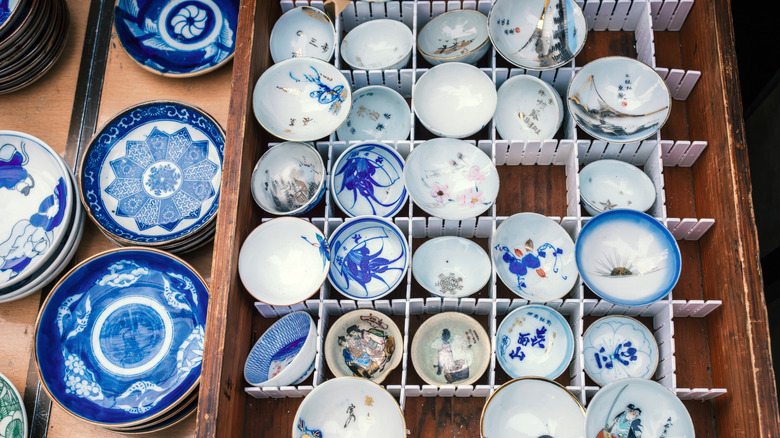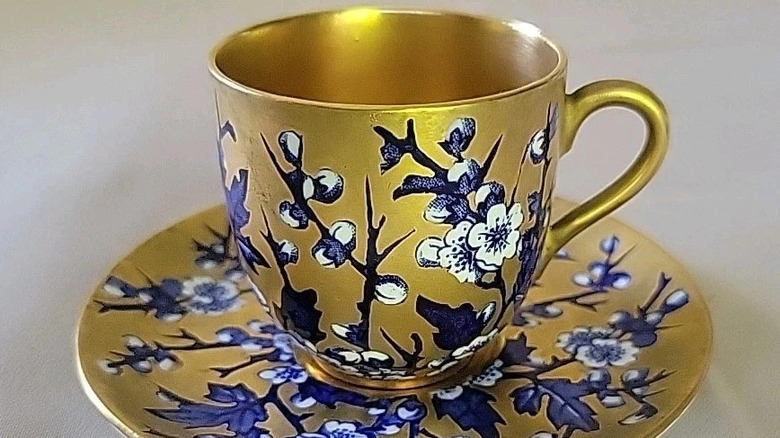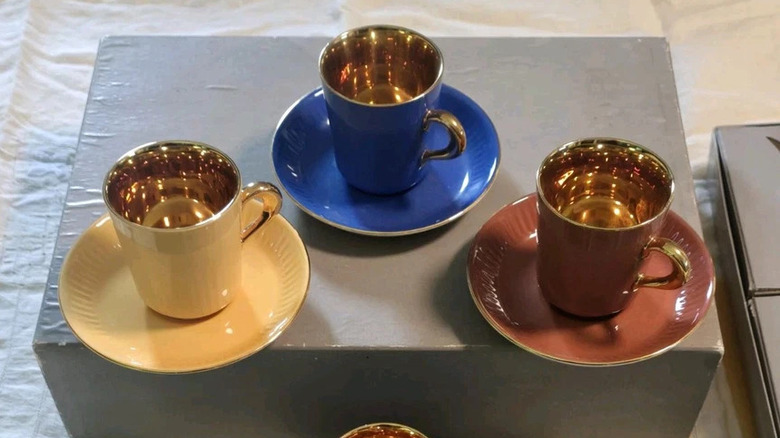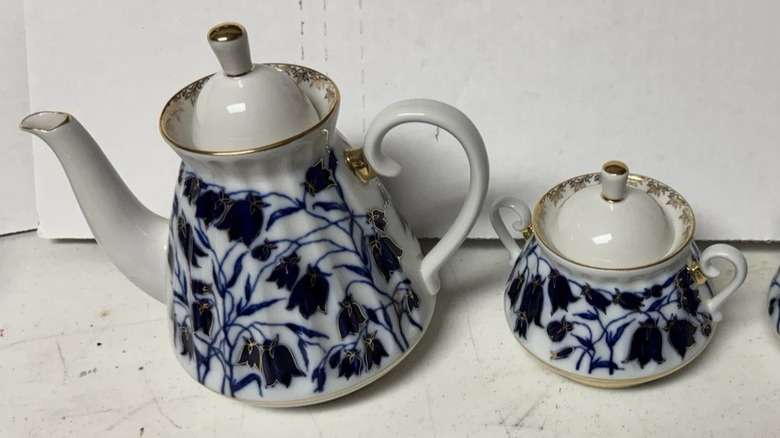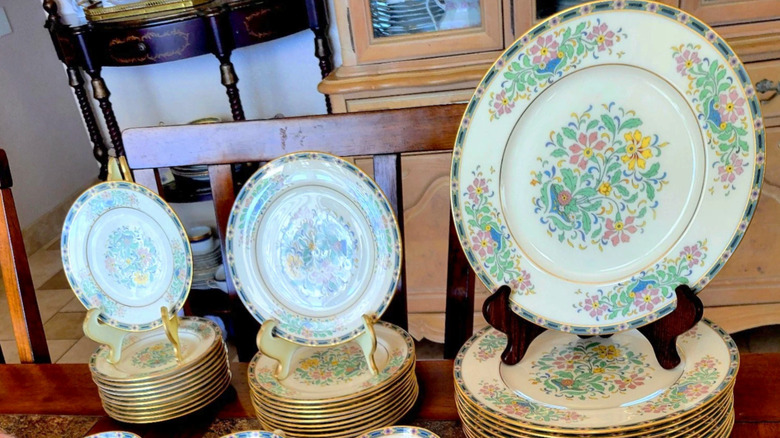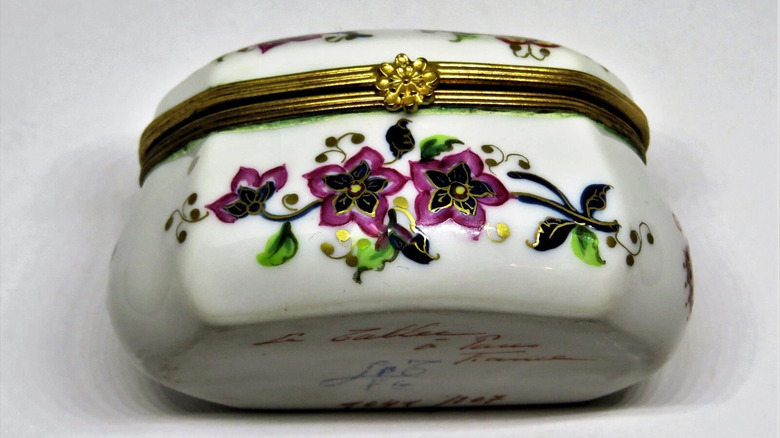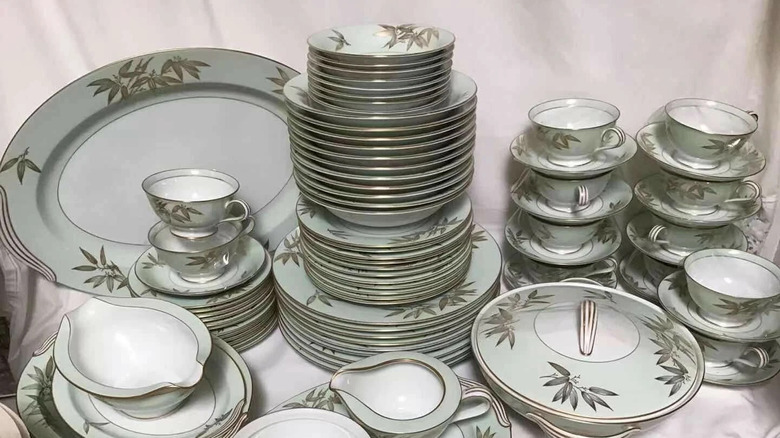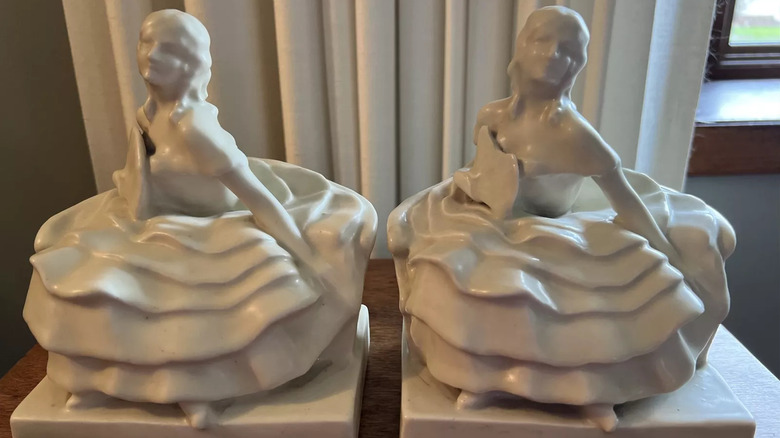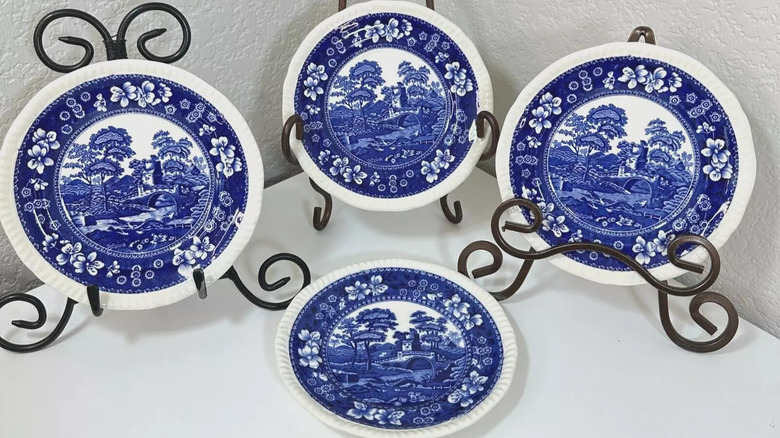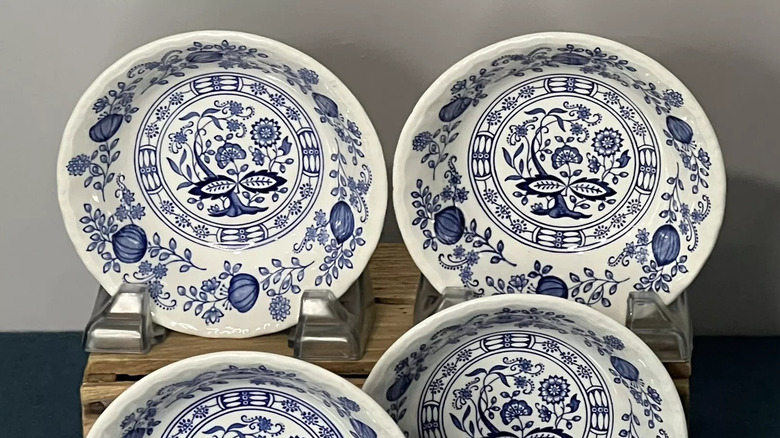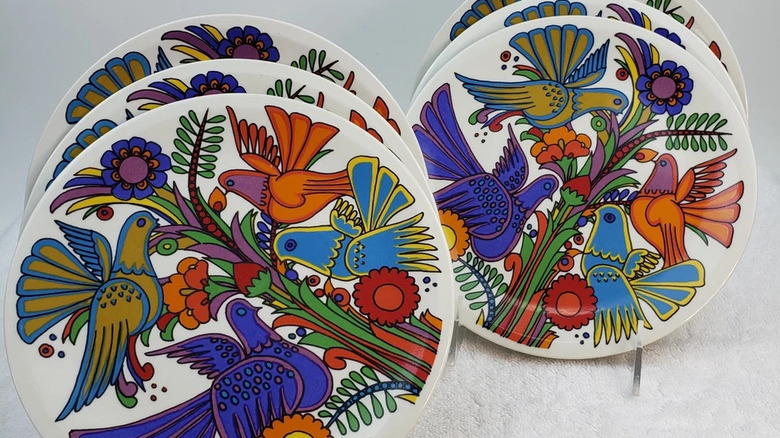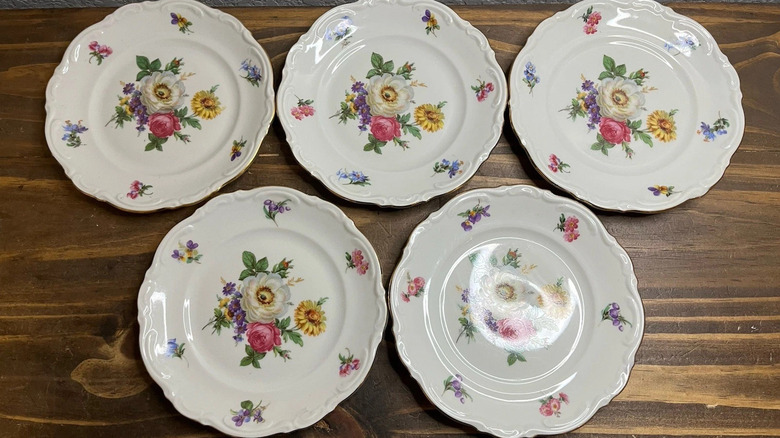11 Valuable Brands Of Vintage Porcelain That Are Worth Looking Out For
We may receive a commission on purchases made from links.
Thrifting has taken off in recent years, with many people using the resources of the internet to seek out unique and valuable home decor. And, thankfully, many vintage porcelain brands produced beautiful works of art that are still in circulation today. They're highly prized by collectors, and you should definitely snag these vintage finds if you see them, due to their historical significance, gorgeous handiwork, and rarity.
Vintage items have a chokehold on thrifters and estate sale rummagers, as there's something truly unique about items created before modern factories and mass production. Many items created throughout the 20th century are valued for more than their artistry and unique pottery-making methods. They are also indicative of their time period, representing key parts in our world's history. They're great assets to resell or put on display in your home, as vintage furniture trends are making a stylish comeback.
Below are 11 well-known vintage porcelain brands worth looking out for the next time you clean out an older relative's home or go thrift shopping. They may look old, but many are worth hundreds of dollars, especially if you have an entire collection and if they are still in pristine condition. Read on to learn about some of the most treasured brands, what they're worth, and how you can verify their authenticity.
Coalport Porcelain Company's gilded and intricate designs are prized in the fine ceramics world
The Coalport Porcelain Company started as The Coalport China Works in 1795 and has maintained its reputation for centuries. The company built a name for itself by creating bone china pieces with blue printed designs. These designs were inspired by Chinese and Japanese ceramics, and they continued to make highly collectible patterns designed to trends at the time up until they were bought out by another notable brand on this list; Wedgwood. The variety in color and cultural inspiration makes it easy to style these thrifted vintage ceramics in your home.
One of Coalport's most collectible lineups comes from the 20th century. The "Countryware" lineup features dishes, napkin rings, sugar basins, oil bottles, and other popular retro kitchen items. They're crafted out of bone china and are void of color, drawing attention to the intricate raised leaf designs embellishing the wares. Highly coveted collections, like the "Countryware" sets, go for around $300 to $400. Less popular pieces or incomplete sets are under $100, but still embody the gorgeous Coalport handiwork.
Coalport used a variety of printed stamps to verify their legitimacy. The standard back stamp featured the crown logo, the brand name, and "A.D. 1750." These prints were often in blue ink and sometimes included the name of the pattern or noted England as their country of origin.
Figgjo is one of the last remaining porcelain companies in Norway, known for their culturally-inspired designs
Founded in 1941, Figgjo is a Nordic company known for the stylistic artwork on their earthenware creations. They emerged during a troubling time period when business wasn't booming, creating refined products for all people. Their ceramics embody Scandinavian art and design and represent the desire for beautiful, but functional, products, especially during the post-war era.
One of Figgjo's 1960s designers, Turi Gramstad Oliver, created some of the more popular designs in demand by collectors. Her series are sold under names like Arden, Elvira, Lotte, and more. A full set of the "Flint Folklore" porcelain set have sold for as high as $140. For the most part, sets from this designer go for around $40 to $100. Other Figgjo collections also go for this amount, but single pieces may not be worth very much, averaging around $15 or less.
Most authentic Figgjo products have their unique company logo in the center. There's also often text stating it was made in Norway, and additional lines naming the designer and name of the collection. However, not all stamped items share this back stamp, and there may be slight differences depending on the designer.
The Imperial Porcelain Factory produced many pieces throughout the historical 20th century
The Imperial Porcelain Factory was the first porcelain factory in Russia in 1744, and it made its mark by putting out various collections for centuries. Amidst the chaos of the 20th century, this factory produced priceless museum-worthy art pieces representative of the time period. After World War II, their designers created masterpieces that represented nature, literary works, and other cultures, and are now old household items that may be more valuable than you think.
Some of the most notable vintage releases were the "Cobalt Net" pattern by Anna Yatskevich and the "Folk" patterns made by Alexey Vorobyevsky. Complete "Cobalt Net" dinner and tea sets go for over $800 at the highest. Smaller or incomplete sets are in the $200 range, while individual pieces are just under $100.
The back stamps for items created under this brand are consistent. The stamp always shows the company logo and text saying "Made in Russia". The stamp is typically a red or faded orange color, and products from the Soviet Union time will say "Made in USSR."
Lenox ceramics were used for the White House table settings and are known for their beautiful artistry
Lenox started up in 1889 and grew to be so renowned that President Woodrow Wilson commissioned 1,700 pieces with the presidential seal. The White House and future presidents continued to utilize this brand throughout the 20th century. They also gained fame through their one-of-a-kind Spice Village spice jar sets that housed individual kitchen spices in small, ornate dollhouses. These are one of the most coveted spice jar sets collectors are always searching for.
You aren't going to find the presidential collections at a random rummage sale, but full sets of other ornate place settings or full Spice Village sets go for over $1,000. Look out for the "Lowell" or "Autumn" patterns that are especially valuable china lineups from Lenox's past. Individual spice houses aren't worth as much without their other pieces, and cost between $5 to $200, depending on their demand.
Lenox still exists, though now under the new name "Lenox Corporation," meaning there are modern-made products out there as well. Identify vintage items by their back stamps. The newer mark is gold and has the "Lenox" name surrounded by laurels. Older stamps also feature the Lenox name along with a calligraphy "L" and "Made in the U.S.A" tagline. Earlier stamps should be a green color ,while later ones are a darker gold shade.
Haviland & Co. drafted many artists to create decorative pieces of incredible quality
Haviland & Co. is another china manufacturer that produced gorgeous presidential plates for U.S. presidents.
The brand popped up in 1842 in New York with the intention of producing French porcelain. Haviland & Co.'s works include pieces designed by glorified painters and sculptors of their time, adding to their historical significance and ascribed value. There is an entire foundation, the Haviland Collectors International Foundation (HCIF), that is highly active today and helps collectors find and identify decades-old pottery.
Some of the most popular patterns come with or without gold trim, such as the "Autumn Leaf" or "Rosalinde" collections. Full dinnerware sets go for around $200 to $400. Meanwhile, luncheon plates, cups and saucers, and individual dishes are in the $30 to $100 range. Many people claim these dinner sets are just as worthwhile to keep, as they are to resell. If you do want to get the best resale value, the aforementioned foundation is a useful asset for pricing these items, and they take personal requests on their website.
The HCIF has also created their own Haviland Backmark guide for identifying authentic pieces. Most vintage back stamps have the Haviland name in a curved font above the location name, "France" or "Limoges". It's a relatively simple stamp that is sometimes found alongside other factory decorator marks.
Noritake ceramic pieces maintained their high quality and reputation throughout the Great Depression
The Noritake china company started in 1904 as Nippon Toki Kaisha Ltd., hand-painting items in Japan, but shaping them to Western preferences. They used many ceramic techniques in their work, including grinding, kneading, molding, firing, and printing. Over their decades of business, they mass-produced products for the most part. However, during the Great Depression and World War II, production decreased, making these collections even more invaluable.
One of their first dinnerware collections, "Sedan," is also one of the most well-known. The "Azalea" pattern also has historical significance, as it was only sold to Larking company club members around the 1940s. There are many Noritake pottery pieces out there, waiting to be foraged by someone who knows a vintage piece, and many sets are worth $50 to $150.
Identifying Noritake wares isn't for the faint of heart. There are over 400 known Noritake marks due. There was even a period when Noritake was marketed under a different name, "Nippon." As the world dove in and out of conflict, Noritake's back stamps have text stating, "Japan," "Made in Japan," "Made in Occupied Japan," and other countries they were produced in. For a better visual representation, you can find some of the more popular back stamps on Gotheborg.com's Japanese Porcelain Marks stamp chart.
Rookwood pieces are symbolic of American history with their multicultural influences
Rookwood pottery is another prized vintage brand that started in the late 19th century. They employed over 200 workers, and at least 136 of those artists have been identified, according to Just Art Pottery. Over the course of 87 years, these artists produced over one million pieces in many styles and textures.
One of Rookwood's most notable works was the "Arts and Crafts" lineup, which was inspired by the Arts and Crafts movement. The brand also took inspiration from the Art Nouveau movement, creating vases, architectural tiles, and other miscellaneous decor in that style. Ceramic vases from this collection and others around the mid-20th century are worth a high price, with most items selling for $50 and up. Especially unique pieces like intricate etching, painting, or shapes are closer to $1,000.
Rookwood's constantly changing styles and pottery techniques could make identifying their pieces difficult. However, they were excellent at marking their goods, making it easy for collectors to recognize a worthwhile piece. The original logo featured a stylistic "RP" to represent their name. As years passed, they added flame markings and Roman numerals to give the exact date of each piece of pottery. Artists also added their ciphers, which is why it's been easy for so many of the artists to be identified and cataloged. Letters were also etched at the bottom to indicate the color of glaze. The one thing to be wary of are the non-printed "X" symbols scratched on the bottom. These X's indicate the created product had minor flaws, deteriorating their value back in the day, and possibly, for some collectors now. This meticulous documentation on their pottery has been a great help for collectors to learn more about vintage china patterns.
Spode pottery was renowned for its Blue Italian range that's still in production
The Spode brand began around the same time as many other historical vintage pottery companies, in the late 1700s. The founder used a glaze firing technique with a brilliant blue color to carve beautiful ceramics inspired by Chinese designs. The company really made its mark with the first release of the "Willow" pattern. They followed this success with the "Blue Italian" collection that was so successful, it remains in production even 200 years later.
Spode may have a few especially esteemed products, but numerous collections have been attributed collectible value over the years. Various plate and dinnerware sets have sold for thousands of dollars at auctions, though most sets range around $40 to $150. Don't expect too much resale value from a "Blue Italian" set, as vintage versions are priced around the same as modern iterations from this centuries-old company.
Back stamps for this brand weren't too complicated, making it easy to identify their products (but not necessarily to date them.) Up until 1970, the family who owned the company, Copeland, put their name in blue print. Sometimes, the "Spode" name was put in conjunction with it. Above it would be the pattern number written in red. After 1970, Spode got a modernized logo with the Spode name, "Made in England" text, the pattern number, and other text describing the collection and its features. Don't lose hope over dating a Spode product just yet — dating is difficult for many of their collections, but some earthenware and bone china was dated up until 1963, with a small impression with the month and two numbers, signifying the year.
Wedgwood crafted classic-art inspired pieces that look like museum relics
Wedgwood came about in 1759 and took off in England. It owes its success to its founder, Josiah Wedgwood, an acute businessman who also melded invention with ceramics. He developed Jasperware, which was unglazed stoneware with carvings inspired by ancient Egyptian, Greek, and Roman culture. Alongside this unique art style, the Wedgwood brand also made iconic patterns, such as "Blue Willow," which was reminiscent of traditional Chinese art.
"Blue Willow" is still in production and was followed by other memorable patterns like "Florentine" and "Edme." Many of their Jasperware creations with ancient reliefs are in high demand by collectors today. Most individual pieces, like trinket boxes, statuettes, and dinnerware sets, range from $40 to over $200. Wedgwood released many works of the same design, and the oldest version of a design is typically considered the most valuable.
Determine the age and authenticity of an alleged Wedgwood piece by recognizing the back mark and its attributed timeline. Vintage works prior to 1940 featured a "W" logo and "Wedgwood England" in text. After the 1940s, their logo was removed, and simple text stating "Wedgwood & Bentley" was stamped on the back. If you find three letters also stamped on the back, a piece may be from before the vintage era, as the letters indicated dates between 1860 and 1906.
Villeroy & Boch's has been making ceramics since the 1700s
Villeroy & Boch is another 18th-century company, and they first gained traction by finding ways to manufacture porcelain to be more affordable. They continued to make a name for themselves over the years, and one of their artists developed Phanolith, a porcelain that combined Jasperware and a paste-on-paste method. This idea garnered attention at the 1900 World's Fair, and their future Bauhaus-inspired works represent German history.
Many of Villeroy & Boch's highest-selling ceramics are from their "Garden Florence" collection, which are unique for their painted fruits on the outer rim of the plates. Aside from these more valuable sets, most of their vintage collectibles are in the $30 to $100 range. Individual pieces are valued on the lower end.
Identify this Bauhaus and Art Deco-style china by various back stamps. Although they swapped the look every decade or so, this company usually stamped their goods with their logo and text that said "Villeroy & Boch." Some products also say the pattern name and where it was made, which varied over the years as the company grew. You can find all kinds of locations listed, such as Jamaica, India, Luxembourg, Germany, Asia, and France.
Meissen produced the first hard porcelain
Meissen started up in the 18th century and is remembered for its "Swan Service" porcelain dinner collection created in the mid-1700s. Pieces of this collection were scattered during World War II, and are considered museum-quality relics. Shockingly, these items pop up in auctions from time to time, and so do their other stonewares that were crafted hundreds of years later.
The antique Meissen ceramics are what truly hold value, as they often go for thousands of dollars. However, many collectors are blind to the fact that the vintage items are also worth looking out for. During the 20th century, the original Messen factory produced decorative pieces, and many are worth $100 to $350, even without being part of a completed collection.
Most Meissen products made in the last hundred years are recognizable by a back stamp with the company name, a crossed swords logo, or both. The company also commemorates anniversaries of some of its most notable achievements, such as their blue Onion Pattern's 250th anniversary and their main factory's 200th and 250th anniversaries, with a date range on either side of the crossed swords logo. Most stamps were made in blue, but some also appear in black.
